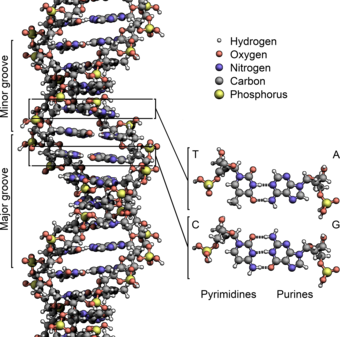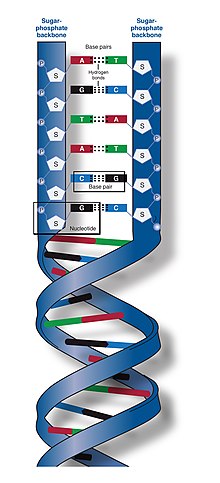Structure and Function of DNA
– DNA is a polymer composed of two polynucleotide chains that form a double helix.
– The two DNA strands are made up of nucleotides, which consist of a nitrogen-containing nucleobase, a sugar called deoxyribose, and a phosphate group.
– The nitrogenous bases of DNA are adenine (A), thymine (T), cytosine (C), and guanine (G).
– The two polynucleotide strands are held together by hydrogen bonds between the complementary base pairs (A-T and C-G).
– DNA carries genetic instructions for the development, functioning, growth, and reproduction of organisms.
– It stores and transmits genetic information from one generation to the next.
– DNA is replicated when the two strands separate, ensuring that each daughter cell receives a complete set of chromosomes.
– Only a small portion of DNA codes for proteins, while the majority is non-coding.
– DNA serves as a template for the synthesis of RNA strands, which are involved in protein synthesis.
Organization and Properties of DNA
– Eukaryotic cells store DNA in long structures called chromosomes.
– Chromosomes are duplicated during DNA replication before cell division.
– Eukaryotic organisms store most of their DNA in the cell nucleus, with additional DNA in mitochondria and chloroplasts.
– Prokaryotes store their DNA in the cytoplasm in circular chromosomes.
– Chromatin proteins, such as histones, compact and organize DNA within eukaryotic chromosomes.
– DNA is a long polymer made up of nucleotide units.
– It can coil into tight loops and other shapes, making its structure dynamic.
– DNA strands are held together by hydrogen bonds between the nucleobases.
– The diameter of a DNA helix is approximately 20 angstroms.
– The buoyant density of most DNA is 1.7g/cm.
– Nucleobases are classified into two types: purines (A and G) and pyrimidines (C and T).
– Uracil (U) replaces thymine in RNA and lacks a methyl group on its ring.
– Adenine pairs with thymine, and cytosine pairs with guanine, forming base pairs.
– Artificial nucleic acid analogues have been created for studying nucleic acid properties and biotechnology.
– Modified bases, such as 5-methylcytosine, can occur in DNA and serve various functions.
DNA Structure and Function in Gene Expression
– Cytosine and adenine play vital roles in epigenetic control of gene expression in plants and animals.
– Noncanonical bases are known to occur in DNA, including modifications of the canonical bases and uracil.
– DNA major and minor grooves provide binding sites for proteins and dyes.
– Proteins, such as transcription factors, usually make contact with the exposed bases in the major groove.
– Unusual conformations of DNA can affect the accessibility of bases in the grooves.
– Complementary base pairing allows nucleobases on one strand to bond with specific nucleobases on the other strand.
– Purines form hydrogen bonds with pyrimidines, with adenine bonding to thymine and cytosine bonding to guanine.
– Watson-Crick base pairs are formed by two nucleotides binding across the double helix.
– GC-content affects the stability of DNA, with high GC-content DNA being more stable.
– Melting temperature is the temperature at which 50% of the double-strand molecules are converted to single-strand molecules.
DNA Amount and Sense/Antisense Strands
– The total diploid nuclear genome per cell in humans extends for 6.37 Gigabase pairs (Gbp).
– Chromosome 1 is the largest human chromosome with approximately 220 million base pairs.
– Mitochondrial DNA (mtDNA) is smaller in comparison to nuclear DNA and forms closed circular molecules.
– Each human mitochondrion contains approximately 5 mtDNA molecules, and each human cell contains approximately 100 mitochondria.
– An egg cell can contain up to 100,000 mitochondria, corresponding to up to 1,500,000 copies of the mitochondrial genome.
– A DNA sequence is called a sense sequence if it is the same as that of a messenger RNA copy that is translated into protein.
– The sequence on the opposite strand is called the antisense sequence.
– Antisense RNA sequences are produced in both prokaryotes and eukaryotes, but their functions are not entirely clear.
– Antisense RNAs may be involved in regulating gene expression through RNA-RNA base pairing.
– Overlapping genes in some DNA sequences blur the distinction between sense and antisense strands.
Alternative DNA Structures and Other Topics
– DNA can be twisted like a rope in a process called DNA supercoiling.
– Supercoiling affects the structure and function of DNA.
– Positive supercoiling occurs when the DNA is overwound, while negative supercoiling occurs when the DNA is underwound.
– Supercoiling plays a role in DNA packaging and gene regulation.
– DNA gyrase is an enzyme that can introduce supercoils into DNA molecules.
– DNA exists in different conformations: A-DNA, B-DNA, and Z-DNA.
– B-DNA and Z-DNA are observed in functional organisms.
– DNA conformation depends on hydration level, DNA sequence, supercoiling, chemical modifications, metal ions, and polyamines.
– A-DNA and B-DNA were first analyzed using X-ray diffraction patterns.
– Watson and Crick proposed the double helix structure based on X-ray diffraction patterns.
– Telomeres are specialized regions at the ends of linear chromosomes.
– Telomeres contain guanine-rich sequences that form G-quadruplex structures.
– G-quadruplex structures are stabilized by hydrogen bonding and metal ions.
– Telomeres also form loop structures called T-loops.
– T-loops have a triple-stranded
Deoxyribonucleic acid (/diːˈɒksɪˌraɪboʊnjuːˌkliːɪk, -ˌkleɪ-/ ⓘ; DNA) is a polymer composed of two polynucleotide chains that coil around each other to form a double helix. The polymer carries genetic instructions for the development, functioning, growth and reproduction of all known organisms and many viruses. DNA and ribonucleic acid (RNA) are nucleic acids. Alongside proteins, lipids and complex carbohydrates (polysaccharides), nucleic acids are one of the four major types of macromolecules that are essential for all known forms of life.


The two DNA strands are known as polynucleotides as they are composed of simpler monomeric units called nucleotides. Each nucleotide is composed of one of four nitrogen-containing nucleobases (cytosine [C], guanine [G], adenine [A] or thymine [T]), a sugar called deoxyribose, and a phosphate group. The nucleotides are joined to one another in a chain by covalent bonds (known as the phosphodiester linkage) between the sugar of one nucleotide and the phosphate of the next, resulting in an alternating sugar-phosphate backbone. The nitrogenous bases of the two separate polynucleotide strands are bound together, according to base pairing rules (A with T and C with G), with hydrogen bonds to make double-stranded DNA. The complementary nitrogenous bases are divided into two groups, the single-ringed pyrimidines and the double-ringed purines. In DNA, the pyrimidines are thymine and cytosine; the purines are adenine and guanine.
Both strands of double-stranded DNA store the same biological information. This information is replicated when the two strands separate. A large part of DNA (more than 98% for humans) is non-coding, meaning that these sections do not serve as patterns for protein sequences. The two strands of DNA run in opposite directions to each other and are thus antiparallel. Attached to each sugar is one of four types of nucleobases (or bases). It is the sequence of these four nucleobases along the backbone that encodes genetic information. RNA strands are created using DNA strands as a template in a process called transcription, where DNA bases are exchanged for their corresponding bases except in the case of thymine (T), for which RNA substitutes uracil (U). Under the genetic code, these RNA strands specify the sequence of amino acids within proteins in a process called translation.
Within eukaryotic cells, DNA is organized into long structures called chromosomes. Before typical cell division, these chromosomes are duplicated in the process of DNA replication, providing a complete set of chromosomes for each daughter cell. Eukaryotic organisms (animals, plants, fungi and protists) store most of their DNA inside the cell nucleus as nuclear DNA, and some in the mitochondria as mitochondrial DNA or in chloroplasts as chloroplast DNA. In contrast, prokaryotes (bacteria and archaea) store their DNA only in the cytoplasm, in circular chromosomes. Within eukaryotic chromosomes, chromatin proteins, such as histones, compact and organize DNA. These compacting structures guide the interactions between DNA and other proteins, helping control which parts of the DNA are transcribed.
1912 NW 143rd Ave #24,
Portland, OR 97229, USA